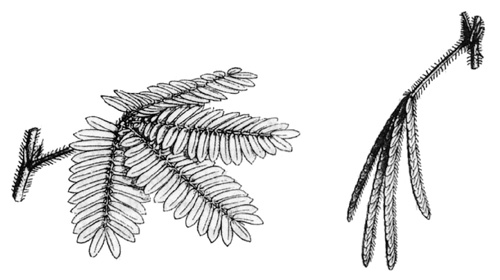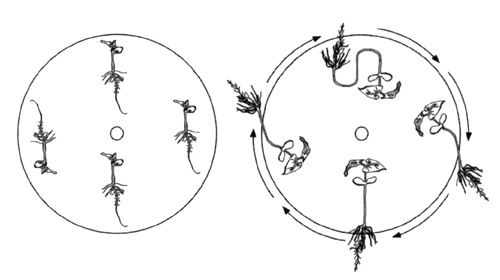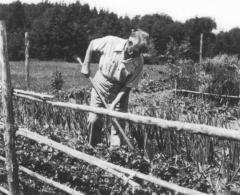
This Article From Issue
September-October 2012
Volume 100, Number 5
Page 420
DOI: 10.1511/2012.98.420
WHAT A PLANT KNOWS: A Field Guide to the Senses. Daniel Chamovitz. viii + 177 pp. Scientific American / Farrar, Straus & Giroux, 2012. $23.
In grassy areas along the equator lives a tiny plant, Mimosa pudica, that has the captivating property of closing its leaves in response to touch. Rest a finger on one leaf, and that leaf and its neighbor will fold abruptly toward the stem. Brush your finger along the length of the stem and every pair of leaves will collapse in turn. For everyone who has wondered at Mimosa , the suddenly snapping Venus flytrap or the way a sunflower’s head unerringly turns to follow the sun, Daniel Chamovitz has written the perfect book.
What a Plant Knows: A Field Guide to the Senses examines the parallels and differences between plant senses and human senses by first considering how we interpret sensory inputs and then exploring how plants respond to similar inputs. Each chapter covers one sense—sight, smell, touch and hearing are covered, along with “How a Plant Knows Where It Is” and “What a Plant Remembers”—and each examines a wide taxonomical range of flora and a complementary historical range of experiments. In the book’s introduction, Chamovitz is careful to clarify his intentions in using language that might be considered anthropomorphic to explore the world of plants:
When I explore what a plant sees or smells, I am not claiming that plants have eyes or noses (or a brain that colors all sensory input with emotion). But I believe this terminology will help challenge us to think in new ways about sight, smell, what a plant is, and ultimately what we are.
A plant biologist who has held positions at Columbia and Yale and is now director of the Manna Center for Plant Biosciences at Tel Aviv University, Chamovitz is well qualified to present an archive of research on plant perception. Happily, he also has narrative dexterity: The book is delightful and a fast read.

From What a Plant Knows
Science, as we all know but sometimes forget, is ultimately driven by curiosity—about what we are, about what other creatures are. That curiosity is evoked repeatedly in What a Plant Knows . When Chamovitz introduces the baffling way that irises appear to “remember” what color of light they last saw or how the parasitic plant dodder (Cuscuta pentagona) can “smell” whether it’s next to a tomato (one of its preferred hosts) or a stalk of wheat, it’s hard not to share his enthusiasm for unraveling these mysteries. He elaborates on elegant early experiments in plant biology as well as modern-day discoveries, providing a window on the work of the many scientists who clarified the mechanisms driving these perplexing phenomena. The latter include the use of genetic mutants of the botanical workhorse Arabidopsis to unveil 11 different photoreceptors that allow the plant to discern, among other things, whether it was last exposed to the red light present in the morning or the far-red light present in the evening. Finely tuned gas chromatography has revealed how dodder differentiates between the attractive chemicals in eau de tomato and the repulsive ones in eau de wheat .

Illustration by Varda Wexler, from What a Plant Knows
In many of the examples Chamovitz describes, insights gained from simple but powerful experiments drive the story. Consider proprioception, the sense of the relative position of our body parts in space that allows us to complete coordinated movements without tripping over our own feet. Do plants have something like proprioception? Certainly, says Chamovitz, but for plants, it’s about the position of their parts relative to gravity. This sense has been the subject of experimental study for more than two centuries. In the mid-1800s, Thomas Andrew Knight set out to test an observation made 50 years earlier by Henri-Louis Duhamel de Monceau: that roots had a propensity to grow down (positive gravitropism) and shoots to grow up (negative gravitropism). With an elegant experiment in artificial gravity, Knight manipulated these tendencies. He arranged bean seedlings in various positions on a circular wooden plate: some with their roots pointing toward the center of the wheel, some with their roots pointing toward the rim. The plate was attached to a water wheel turned by a stream; it spun at 150 revolutions per minute. The spinning created a local reactive centrifugal force that was stronger than gravity. No matter how the plants were initially positioned, they grew in the same way: root toward the new perceived gravitational force—the rim—and shoot away from it. Charles Darwin, intrigued by this phenomenon, turned his now-underappreciated botanical inclinations toward the problem some years later. Working with his son Francis, he sliced varying lengths off of the roots of bean, pea and cucumber seedlings and then laid the seedlings horizontally on damp soil. The Darwins noted that cutting off 0.5 mm or more of a seedling’s root tip resulted in horizontal root growth but no downward growth. In another experiment, they placed seedlings sideways on pins and cauterized their root tips with silver nitrate. This caused the roots to cease growing downward. Uncauterized seedlings’ roots reliably grew down. These and other experiments suggested that the root’s ability to sense gravity resides in the root tip. But the mystery of how shoots orient themselves away from gravity remained. Chamovitz continues to follow the study of gravitropism through history, describing the adventures of plants in space and the insights gained from mutant plants that lack the ability to sense gravity. These experiments, he writes, have revealed a surprising parallel between statoliths, structures in the root cap and endodermis of plants that allow them to sense gravity, and otoliths, subcellular structures in the human inner ear that help us maintain our balance.
Even as he relates the intricate mechanisms of plant perception, Chamovitz maintains a breezy and accessible style with apt and playful analogies (as when he likens experiments that change plants’ cycle of day and night to jet lag in humans). Although biologists will likely be familiar with some of the examples he offers, his description of the experimental paths that have led to various discoveries will entertain experts and newcomers to the subject alike. He shows remarkable restraint against the temptation to lead with detailed diagrams of plant anatomy, instead introducing apical meristems or cotyledons when an anecdote relies on them. The book includes a thorough bibliography for those who want additional detail about particular concepts or experiments. And each chapter is enhanced by black-and-white illustrations and frequent links to online videos of things like circumnutating seedling tips and dodder’s python-like death grip.
The reach of What a Plant Knows extends beyond plant biology: Plant senses become a surprisingly successful vehicle for the description and explanation of a broad suite of genetic concepts. Forward and reverse genetic screens; mutagenesis techniques; necessity and sufficiency; and the vagaries of gene naming (as for the scarecrow and werewolf genes) are introduced with clarity. Even epigenetics, which epigeneticists themselves often struggle to define, is covered with deft ease in the context of heritable stress responses.
Knowing more about what a plant knows, readers may find themselves struck by a sudden awareness that the unprepossessing houseplants in the living room have been quietly taking note of which windows are open, when the light bulbs were last changed and how ripe the bananas are. The book also offers an enticement to rediscover the Mimosa plant armed with the secret (which I won’t spoil) of how it does its collapsing trick. But perhaps most satisfyingly, Chamovitz conveys the sense that our knowledge of the range and limitations of plant perception is a work in progress and that much remains to be discovered.

American Scientist Comments and Discussion
To discuss our articles or comment on them, please share them and tag American Scientist on social media platforms. Here are links to our profiles on Twitter, Facebook, and LinkedIn.
If we re-share your post, we will moderate comments/discussion following our comments policy.